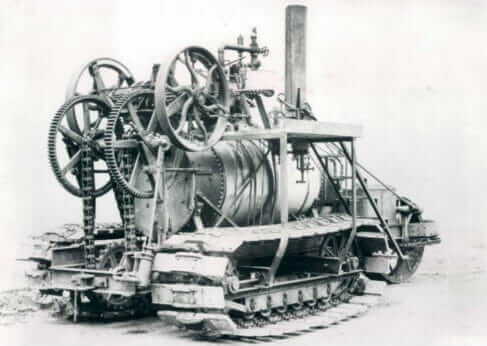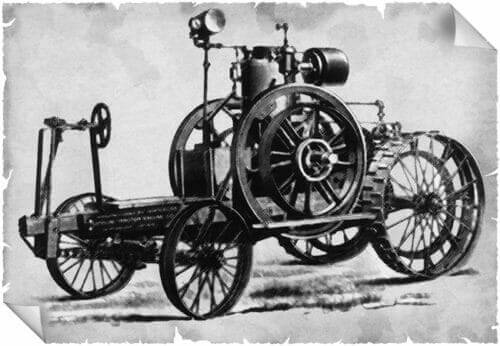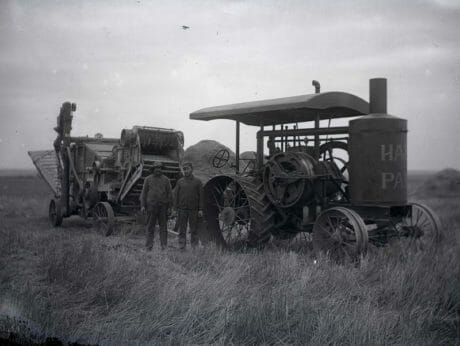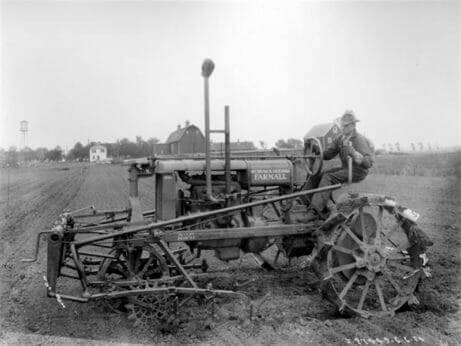Happy 100th Birthday to the Mass-Produced Tractor!
Henry Ford’s Model F tractor turned 100 this year. John Deere tractors are celebrating the same landmark in 2018. Let’s celebrate!
Happy 100th Birthday to the Mass-Produced Tractor!
Henry Ford’s Model F tractor turned 100 this year. John Deere tractors are celebrating the same landmark in 2018. Let’s celebrate!

Fordson fans (that’s the brand name of Ford’s original tractors) from Australia to the UK have staged major hoedowns over the past year. Should you find yourself in the Detroit area, stop in at the Ford family estate in Dearborn, where there is a special tractor exhibit to commemorate the centennial. For the under-12 contingent, special edition toy tractor sets have been issued to mark the occasion. The Smithsonian has even declared 2018 as the Year of the Tractor, and will be showcasing a vintage John Deere model at the National Museum of American History in D.C.
Here at Modern Farmer, we thought we’d celebrate with a little cruise down memory lane.
1850s: John Fowler and Company – Steam Tractor

Inventors tinkered with the idea of a steam-powered tractor throughout the 19th century, but the British Engineer John Fowler is credited with introducing the first commercially-viable models in the 1850s, one of which is pictured above. If it reminds you of a steam locomotive, that’s because the design is derived from the trains of the day.
1890: Holt Manufacturing Company – Crawler Tractor


Early tractors had enormous steel wheels that were unimaginably heavy and had poor traction. To improve performance in wet conditions, Benjamin Holt came up with the design for the crawler-type tractor – the steam-powered model pictured here had wooden tracks – toward the end of the 19th century. His company eventually became Caterpillar, which continues to make track-based farm and construction equipment today.
1892: Waterloo Gasoline Engine Company – Gas-Powered Tractor[/mf_h2]


Steam-powered tractors were heavy, clunky, and never became widely used. Hoping for a more maneuverable design, Iowa inventor John Froelich came up with the first gasoline-powered tractors in the 1890s. These didn’t catch on immediately either, though Froelich’s tractor outfit, the Waterloo Gasoline Engine Company, was eventually purchased by John Deere. (Because 2017 is the quasquicentennial – translation: 125th anniversary – of this important event, the Froelich Museum in Froelich, Iowa recently had a big celebration.)
1906: Hart-Parr Tractor Company ”“ First “Tractor” Tractor

Tractor development was picking up by the turn of the century, with more and more companies getting into the business. One of those was Hart-Parr, which was established in Iowa in 1901. In 1906, looking to differentiate their machines on the increasingly crowded market, the owners decided to call their machines “tractors.” Previously, everyone referred to them as “traction engines.”
1917: Fordson ”“ Model F

Most Americans are familiar with the Model T Ford, the first affordable, mass-produced car, which was introduced in 1908. But other than agricultural history buffs, few realize that Henry Ford also had a wildly successful line of tractors, which he launched under the name Fordson in 1917. Ford called the Model F, his first successful design, the “automobile plow,” and agricultural commentators of the day hailed it as the “Model T of the soil.” Selling for about $750, it soon gained a reputation among farmers as cheaper than horses to own and maintain, setting tractors on a trajectory to outpace livestock as the primary source of farm power over the next few decades.
1918: John Deere ”“ Waterloo Boy Tractors

John Deere, the man, was born in 1804. A blacksmith, he started manufacturing agricultural implements in 1837. Deere became famous for his horse-drawn plows, but was long dead by the time his company started selling tractors in 1918, the year they acquired Froehlich’s outfit, the aforementioned Waterloo Gasoline Engine Company. At the time, their most popular model was known simply as the Waterloo Boy, though this was soon replaced with a John Deere-branded machine. The company quickly grew into the largest tractor manufacturer in the world.
1923: International Harvester ”“ The Farmall


The introduction of International Harvester’s Farmall line of tractors in 1923 is considered a watershed moment for the modern tractor. Earlier machines were designed primarily for one specific task. The Farmall, on the other hand, did it all: plowing, harrowing, seeding and more. The key to this was the invention of the PTO (power takeoff) shaft, which transferred power from the motor to any number of implements pulled behind the tractor. Up until this time, farmers typically kept a team of horses for any tasks that their tractor couldn’t handle, but the PTO liberated farmers to fully embrace machine power.
1939: Fordson – Model N

One final feature that cemented the basic design of the modern tractor was the three-point hitch – little more than a triangle of metal at the back of the tractor for attaching implements (most modern tractors have both a PTO shaft and a three-point hitch, which are used for mounting different types of equipment). The three-point hitch is typically attached to a hydraulic system that can lift heavy implements off the ground when not in use, saving a farmer’s back. The concept had been around for many years, but the Fordson Model N series, which debuted just as World War II began (the women above are harvesting beets while their husbands were at war), is considered the machine that perfected modern tractor design – and little has changed in the intervening years.
SaveSave
Follow us

This work is licensed under a Creative Commons Attribution-NoDerivatives 4.0 International License.
Want to republish a Modern Farmer story?
We are happy for Modern Farmer stories to be shared, and encourage you to republish our articles for your audience. When doing so, we ask that you follow these guidelines:
Please credit us and our writers
For the author byline, please use “Author Name, Modern Farmer.” At the top of our stories, if on the web, please include this text and link: “This story was originally published by Modern Farmer.”
Please make sure to include a link back to either our home page or the article URL.
At the bottom of the story, please include the following text:
“Modern Farmer is a nonprofit initiative dedicated to raising awareness and catalyzing action at the intersection of food, agriculture, and society. Read more at <link>Modern Farmer</link>.”
Use our widget
We’d like to be able to track our stories, so we ask that if you republish our content, you do so using our widget (located on the left hand side of the article). The HTML code has a built-in tracker that tells us the data and domain where the story was published, as well as view counts.
Check the image requirements
It’s your responsibility to confirm you're licensed to republish images in our articles. Some images, such as those from commercial providers, don't allow their images to be republished without permission or payment. Copyright terms are generally listed in the image caption and attribution. You are welcome to omit our images or substitute with your own. Charts and interactive graphics follow the same rules.
Don’t change too much. Or, ask us first.
Articles must be republished in their entirety. It’s okay to change references to time (“today” to “yesterday”) or location (“Iowa City, IA” to “here”). But please keep everything else the same.
If you feel strongly that a more material edit needs to be made, get in touch with us at [email protected]. We’re happy to discuss it with the original author, but we must have prior approval for changes before publication.
Special cases
Extracts. You may run the first few lines or paragraphs of the article and then say: “Read the full article at Modern Farmer” with a link back to the original article.
Quotes. You may quote authors provided you include a link back to the article URL.
Translations. These require writer approval. To inquire about translation of a Modern Farmer article, contact us at [email protected]
Signed consent / copyright release forms. These are not required, provided you are following these guidelines.
Print. Articles can be republished in print under these same rules, with the exception that you do not need to include the links.
Tag us
When sharing the story on social media, please tag us using the following: - Twitter (@ModFarm) - Facebook (@ModernFarmerMedia) - Instagram (@modfarm)
Use our content respectfully
Modern Farmer is a nonprofit and as such we share our content for free and in good faith in order to reach new audiences. Respectfully,
No selling ads against our stories. It’s okay to put our stories on pages with ads.
Don’t republish our material wholesale, or automatically; you need to select stories to be republished individually.
You have no rights to sell, license, syndicate, or otherwise represent yourself as the authorized owner of our material to any third parties. This means that you cannot actively publish or submit our work for syndication to third party platforms or apps like Apple News or Google News. We understand that publishers cannot fully control when certain third parties automatically summarize or crawl content from publishers’ own sites.
Keep in touch
We want to hear from you if you love Modern Farmer content, have a collaboration idea, or anything else to share. As a nonprofit outlet, we work in service of our community and are always open to comments, feedback, and ideas. Contact us at [email protected].by Brian Barth, Modern Farmer
December 29, 2017
Modern Farmer Weekly
Solutions Hub
Innovations, ideas and inspiration. Actionable solutions for a resilient food system.
ExploreExplore other topics
Share With Us
We want to hear from Modern Farmer readers who have thoughtful commentary, actionable solutions, or helpful ideas to share.
SubmitNecessary cookies are absolutely essential for the website to function properly. This category only includes cookies that ensures basic functionalities and security features of the website. These cookies do not store any personal information.
Any cookies that may not be particularly necessary for the website to function and are used specifically to collect user personal data via analytics, ads, other embedded contents are termed as non-necessary cookies.